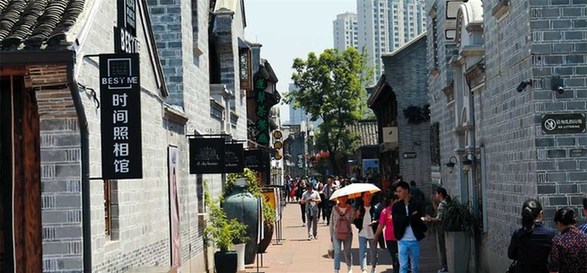Escaping urban frenzy in a seaside excursion
 0 Comment(s)
0 Comment(s) Print
Print E-mail Shanghai Daily, June 14, 2017
E-mail Shanghai Daily, June 14, 2017

I'm always on the lookout for things to do on the weekend, and sometimes it’s preferable to get out of one of the world’s most populous cities for something a little more low-key. One option is the port city of Ningbo in Zhejiang Province.
Located 140 miles directly south of Shanghai across Hangzhou Bay, Ningbo — which literally means “tranquil waves” — is one of the world’s busiest ports. The best way to get there is by high-speed rail, which takes just two to three hours from Shanghai’s Hongqiao Railway Station.
If you’re particularly game, you could also drive there, taking advantage of the Hangzhou Bay Bridge that opened in 2008.
As soon as you arrive, you’ll instantly notice a slower pace of life than in Shanghai. It’s a welcome respite from the hustle and bustle.
Ningbo has a long history as one of China’s more important trade centers. It was a key hub in the days of the old Silk Road more than 2,000 years ago. Later, during the First Opium War (1840-42), Ningbo was one of the five Chinese ports force-opened by gunboats to Western trade.
Today, commerce still looms large in the local economy. The city exports electronics, food, tools and other commodities.
But shipping and exports aren’t much of a reason to spend a weekend away here. Instead, you’ll be wanting to check out what Ningbo has to offer. I chose a slow, more relaxed weekend, not trying to squeeze in too many sights. For the more ambitious, there are endless choices.
Nantang Old Street
I chose to start at Nantang Old Street, which was highly recommended by friends who have visited Ningbo. Basically, it’s a renovated old street — just as you might imagine — that serves as an outdoor market. It’s a cute, albeit quite commercial place to try some of the local delicacies and buy souvenirs.
Ningbo cuisine, known as yong cai, heavily features seafood because of the close proximity of the sea. There’s no shortage of it along Nantang Old Street. I don’t eat seafood, but I tried another of Ningbo’s delicacies, tangyuan (sweet glutinous rice dumplings). They were okay.
Cafes on the street sell the usual fare, including knickknacks.
The Old Bund
Forget Shanghai’s famous Bund. Ningbo’s Old Bund is where it’s at! And, interestingly enough, the Old Bund predates its Shanghai counterpart.
The Old Bund is a hive of activity at night, with restaurants, cafes and bars catering to young and old party animals who drink beer as they listen to live musical performances.
If you’re not into drinking alcohol, the area is still a must-stroll just to soak up the lively atmosphere.
The Old Bund features dozens of restored old buildings, as well as some new ones, lavished tastefully with colorful lights.
Ningbo Museum
The Ningbo Museum is worth a visit for the architecture alone.
The building was designed by renowned architect Wang Shu, who was the first Chinese national to win the esteemed Pritzker Architecture Prize for his work on this museum. The façade is formed from pieces of broken brick salvaged from demolished buildings.
Permanent exhibits highlight Ningbo history and customs. A bamboo art display is on the third floor.
Don’t pass up the chance to have a cup of coffee at the museum’s funky rooftop café.
Tianfeng Tower
You’ll probably feel obliged to tick off at least one historic structure during your visit to Ningbo. If you love seafood, choose Tianfeng Tower, which hosts an abundance of seafood markets and restaurants.
The tower was built during the Tang Dynasty (AD 618-907) and updated during the Song Dynasty (960-1279). After taking an obligatory selfie here, head across the street to one of the many seafood markets for a bite to eat. I was happy just taking pics.
Zhuang Yuan Lou restaurant
I probably will be a bit more wary about recommendations from friends after eating at the Zhuang Yuan Lou, which is reputed to be one of Ningbo’s best restaurants.
For me, it rated one star out of five for its slack service, dull food and “foreign” objects found in some of the dishes.
Even though I arrived early when the restaurant had only a handful of guests, the food took up to an hour to arrive.
The dishes came sporadically, with gaps of up to 20 minutes apart. I found a piece of Styrofoam in one dish and a long human hair in another.
To be fair, maybe the restaurant was just having a bad day. The manager apologized and promised special treatment on any repeat visit, but I definitely won’t be going back.
How to get there: It’s about two hours by high-speed rail from Shanghai to Ningbo. If you drive, it takes around three hours — via G60, Hangzhou Bay Bridge and Shenhai Expressway.






Go to Forum >>0 Comment(s)